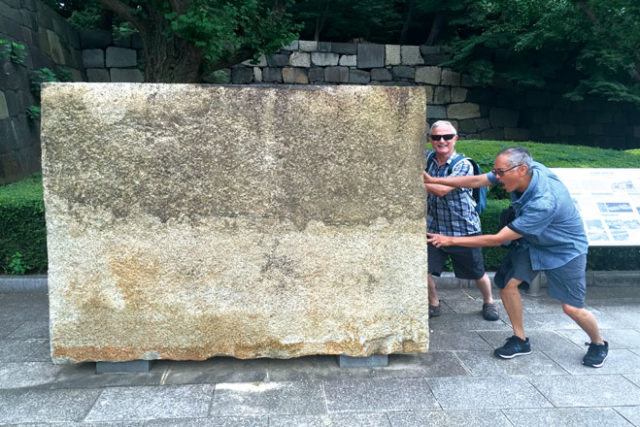
By Eileen Yamada Lamphere
For The North American Post
This author joined the North American Post’s annual group tour to Japan. This is the second in a series of articles by tour members.
Oh, what a difference a year makes! Last year at this time, I was overwhelmed by my travels in Japan with all five senses on overload for eight days. This year, I was able to focus more on what my senses were encountering. In Tokyo, while presented with a Japanese-style Chinese dinner, I could distinguish the similarities and differences between a typical fare in Seattle and what lay before us. At a traditional eight-course Japanese dinner, I had the time to investigate the origins of the dishes and the unique preparations. I learned that each course is served in small quantities, in small bowls or small plates, because each selection beckons the diner to want more. After three and a half hours, and over a dozen dishes later, I no longer wanted more, but I did learn a lot about tradition, selection, and historic preparation.
Our travel west to Takayama brought cultural traditions and historic customs, and this time I could focus. We spent thirty wonderful minutes on the 12th floor in the onsen, a traditional Japanese bath. We washed and soaked, overlooking the village, which was tranquil, despite the rain. A morning walk led us to the Miyagawa morning market along the river and the Jinya-mae market at the Jinya shrine. Both were full of the sounds of small farmers and artisans, talking among themselves and customers. The smells of fresh fruits, vegetables, and flowers filled the air cleaned by the night rain. And, unique crafts, clothing, and souvenirs abound!
Our journey to Shirakawa-go brought a whole different perspective to Japanese living. We took our time to explore the oldest building, the Kanda House, and discovered how it was built and has lasted since 1460. The family raised silkworms and in the 4th floor attic space are antique looms and a variety of woven items. In the basement, the Kanda family made “fuming nitric acid,” which is an ingredient of gunpowder! This village of over 114 buildings is amazing with 18-inch thatched roofs, and most buildings are in use as either homes or businesses.
Further west in Kanazawa, we explored the Edo-era business district with its small art museums and crafts stores. We met a couple walking down the street dressed in traditional wedding kimonos which drew the attention and cameras of many of us! Only as we were leaving, did I find out that the second story of many businesses were homes of geishas! They live in grand style. We also explored the Kenrokuen Garden. This garden started in the 17th century and has classic and traditional landscape designs with ponds and streams. What stands out are the various techniques used to brace the trees and their branches. These techniques add to the form and structure of the growing plants. On this visit, it was pouring down rain, but we came across a group of either monks or simply workers, dressed in blue slickers. Bent over on their hands and knees, they were weeding a lawn area without stopping, neither distracted by the visitors or the rain. That is dedication!
The Himeji Castle was different, yet similar to the Osaka Castle from last year. Anything over six stories tall, built over 400 years ago, has to be impressive. This white-washed castle is actually 83 buildings and represents the classic Japanese architecture. I was in awe looking at the metal hinges and massive beams used in construction before forged metal and cranes!
Our bus tour of Kyoto castles took us to Nijo Castle, The Kinkaku-ji Temple (more commonly known as the Golden Pavillion), and the Kyoto Imperials Palace. The gardens and reflecting ponds of the Kinkaku-ji were mesmerizing. As the winds blew and the shadows from the tree bent, the reflection changed its picture. Seeing the inside of a castle challenges the imagination, wondering constantly what it must be like to live in the place, as the tour guide tries to direct your attention elsewhere. One piece of new information is there are intentionally “squeaky” nightingale floors built into the hallways of the palace. If one listens while stepping there is a squeak that, according to castle lore, fooled even the ninjas!
No visit to Japan is complete without a stop in Hiroshima. Last year, this was the most impressive stop for me because of family origins and knowing the nature of war. This time the remains seemed to sing a slow soft song; not a sad song, but a reflective one of remembrance. Gentle winds and small splashes of the river, accompanied the walk around the Atomic Dome. Many times I stopped and wondered why one wall was standing and another was in ruins. I wondered what once decorated those walls and who was standing near them. Various small shrines built into alcoves of the hedge made me pause and honor that day. Inside the Peace Museum were various artifacts and pictures of that day, but one striking display held the cranes and message left by President Obama.
Our trip came to an end with a vow to return. I said that last year and I came back! Next time we want the grandchildren to join us. They will be old enough to understand the history and to appreciate the culture and traditions. Thank you to the North American Post, Elaine Ko and Shigeki Kajita for making this trip possible. I am amazed how ten random people could come together and create wonderful memories, so thank you to Howard, Jane, Jean, John, Gwen, Gary, and Melvin! Domo arigato!






